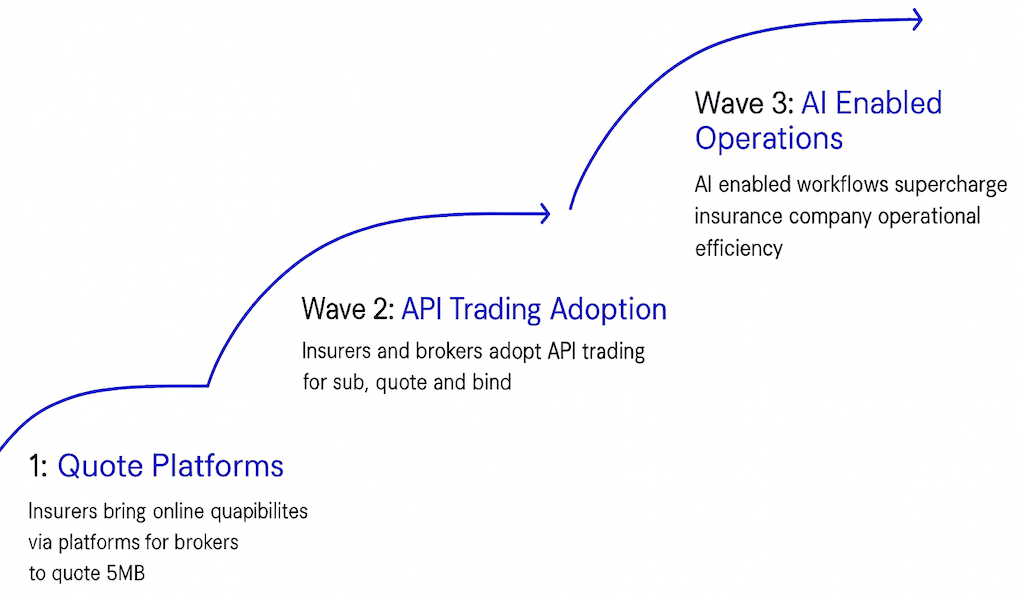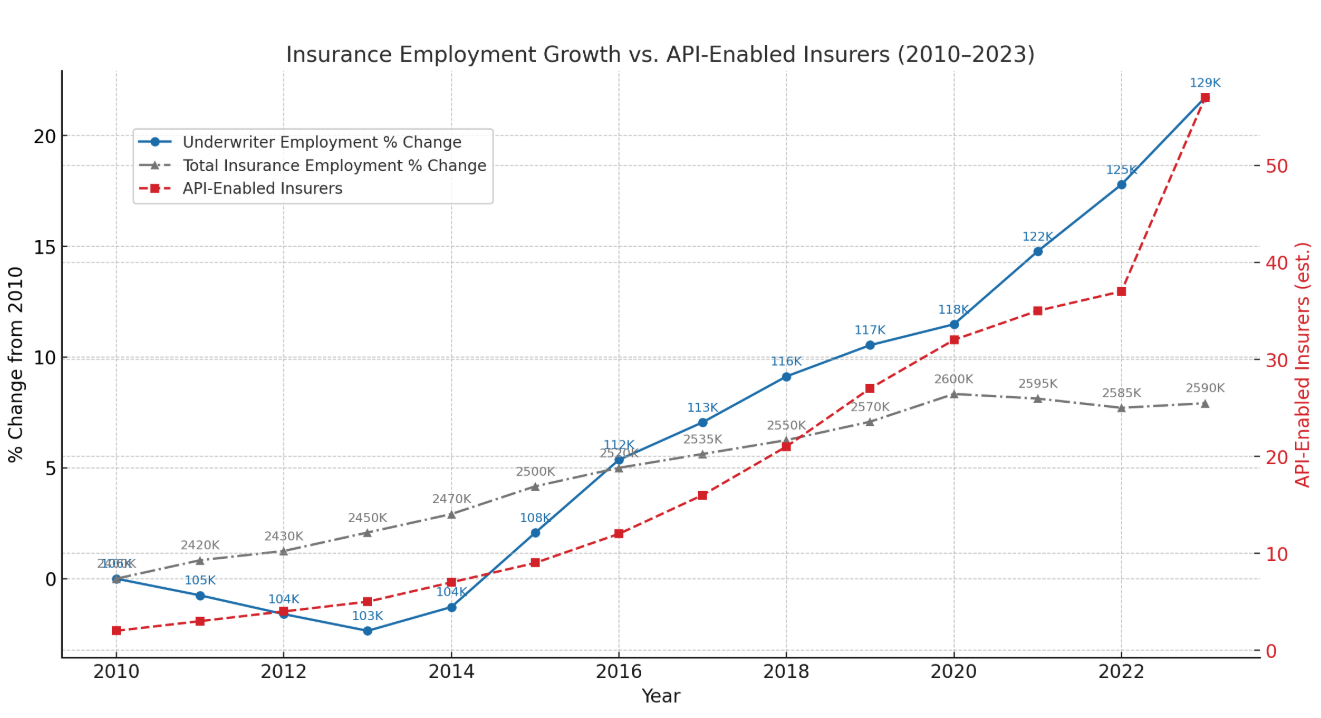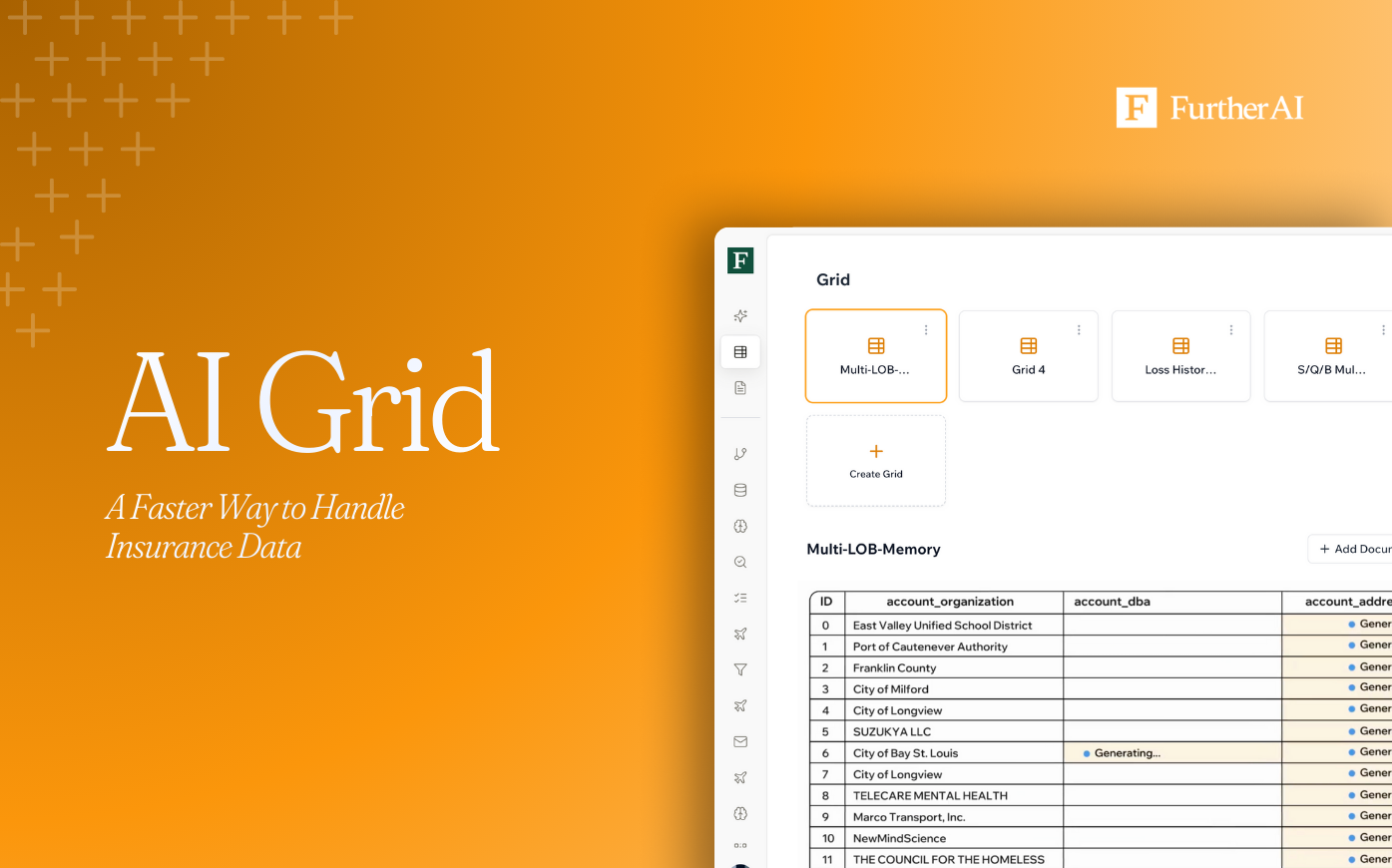
By Ben Grosser, Head of Insurance AI, FurtherAI
AI changes how a fully optimized insurance organization operates. It isn’t a threat to insurance; instead, it’s the LEGO building blocks for an incredible competitive moat.
Over the last 20 years, commercial insurance digitized quoting with broker platforms and then compressed time-to-quote with APIs.
The next wave—AI-enabled workflows—targets the stubborn, high-friction work that still slows us down.
In this blog, I contextualize a bit of history (How We Got Here) and a select basket of opportunities:
- Opportunity 1: >10x Operational Efficiency Gains
- Opportunity 2: Supercharged Employment
- Opportunity 3: FurtherAI De-Risks Early Adoption
Insurers that adopt AI now will widen their operational and underwriting moat; the real risk is hesitating.
AI Compliments Already Adopted Digital Quoting Technologies
First came insurer-hosted online quote platforms that digitized submissions and multiplied capacity. Then API-based trading collapsed week-long cycles into minutes.
Today, AI workflows are rewriting how underwriters, brokers, and operators get work done—faster, cleaner, and without the busywork.
This sequence matters.
Platforms digitized the interaction. APIs accelerated the transaction.
AI now optimizes the work itself—the extraction, triage, classification, and validation that still consumes teams.

Insurers which leverage the power and unparalleled quote-time SLA of already-enabled digital quoting capabilities while now moving fast to supercharge operational efficiency via AI-enabled workflow will reap the rewards of first mover advantage.
Opportunity → 10× Operational Efficiency (With Proof, Not Hype)
Most carriers still burn hours per submission on rote steps: opening emails, parsing ACORDs and loss runs, rekeying data, clearing accounts, and stitching together carrier/TPA/vendor artifacts.
AI attacks these exact tasks.
- <1 minute at >95% accuracy submission intake & clearance across the most common document types and formats.
- >15× faster path-to-underwriting file readiness versus manual prep.
- >500% ROI when you quantify time saved, cycle-time compression, and improved hit/close ratios versus solution cost.
These are the right first wins because they’re measurable, reversible, and infrastructure-light—no core systems surgery required. They feed better data to your existing rating, appetite, and rules, raising decision quality while cutting unit cost.
Opportunity → Happier Teams (And Employment Stays Strong)
AI doesn’t replace underwriters; it unlocks them.
Your best people should spend time on selection, negotiation, and portfolio strategy—not rekeying tables from messy PDFs.
What changes for your people:
- Less swivel-chair work; more portfolio thinking and broker engagement.
- Faster, richer context per risk; better selection without burning cycles.
- Clearer career paths into data-augmented underwriting, product, and ops leadership.
History keeps proving the doomsayers wrong.
If you remember the “APIs will kill underwriting” headlines, you also remember how that turned out.
For example, in 2015, Risk&Insurance penned “Will Technology Replace Underwriters?”. They unabashedly claimed that “insurance underwriters are an endangered species” as “Technology and automated solutions are reducing the need for humans”.
But the doomsayers’ predictions didn’t come to bear. Instead, the market accelerated—and so did skilled jobs. Expect the same with AI: more capacity, better data, and more demand for expert judgment.
The last two tech waves prove the point: despite predictions of widespread displacement when platforms and then APIs arrived, industry employment grew and underwriter roles increased as throughput expanded and product breadth rose.

Between 2015–2025, total insurance employment rose roughly 8% and underwriting roles grew a bit over 20%, even as digital/API capabilities surged across carriers and products.
By year-end 2024, industry indexes tracked on the supply side showed roughly 224 API-enabled products across ~85 carriers in ~24 lines, with carriers offering digital capabilities up ~50% and API-enabled products up ~45% from 2022–2024.
Opportunity → A Clear Path Forward with FurtherAI
At FurtherAI, we work with carriers, MGAs, reinsurers, and brokers to turn AI from a risky experiment into durable advantage. The biggest blocker we hear is not the technology but the unknowns: where to start and how to adopt responsibly.
Our approach begins with your business—your book, lines, and underwriting model—and builds a roadmap that lands value quickly while respecting governance and controls. We start with trusted document flows, add quality checks and human exception handling, then embed AI steps directly into existing workflows like intake, clearance, extraction, enrichment, and file assembly.
The result is an adoption playbook tailored to your operations, not a plug-and-play demo. This lowers coordination risk, compounds wins internally, and gives teams measurable gains without disrupting how you price risk.
What “good” looks like in practice:
- Strategy & scoping: Align on target LOBs, partners, SLAs, controls, and guardrails.
- Process modeling: Identify high-friction steps with high doc density (submissions, schedules, endorsements).
- Pilot → embed: Launch a narrow slice (e.g., small commercial new business intake), measure accuracy/latency, then embed into production queues.
- Controls & monitoring: Add validation rules, sampling, exception queues, and drift monitors so gains stick.
- Scale: Expand to renewals, endorsements, claims FNOL supplements, and bordereaux cleansing.
The outcome: underwriting-ready files in minutes, richer structured data for analytics, and more capacity per underwriter—without changing how you price risk.
Act, don’t wait.
The moat is built by the carriers that convert documents into decisions—accurately, repeatedly, and at scale. AI is how you get there.
About the author
Ben Grosser is Head of Insurance AI at FurtherAI. He previously founded Telivy (YC S21, acquired 2024), sat on multiple Boards, led Underwriting and Insurance Product at At-Bay (2017–2020), and spent eight years (2009 - 2017) underwriting and managing management, professional and cyber underwriting teams at various insurers.
Ready to Go Further &
Transform Your Insurance Ops?
Reclaim your time for strategic work and let our AI Assistant handle the busywork. Schedule a demo to see how you can achieve more, faster.
















